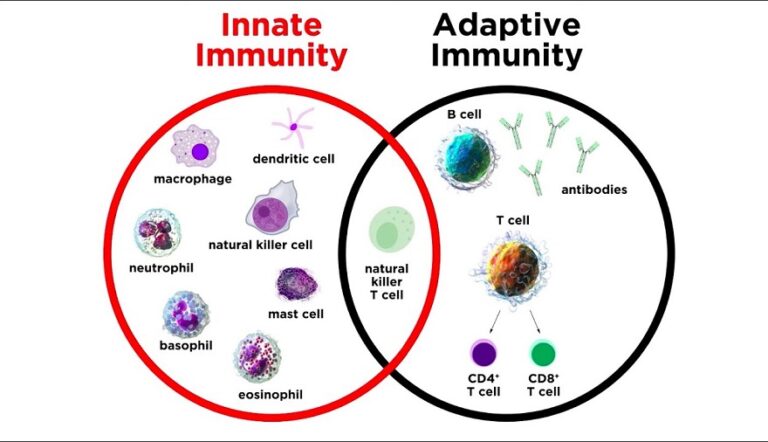Have you ever noticed that over time you recover faster and faster from the flu, or a small infection? Your adaptive immune system takes care of this.
As the word suggests, adaptive immunity is one that arises in response to and adapts to infection.
The adaptive immune system is a vigorous and sophisticated defense system that enables an organism to fight off invading pathogens.
Through specific identification, the adaptive immune system amplifies the innate response, and generates immune memory.
These mechanisms serve to strengthen defenses after repeated exposure to the same aggression.
Read on to learn how adaptive immunity works and what are the components and mechanisms of this response system.
RELATED: How to Strengthen the Immune System?
What is the adaptive immune system?
By definition, adaptive immunity (also known as acquired or specific) is all the mechanisms, cells and molecules involved in the late response of the immune system .
To fight an infection, the adaptive immune system can take days, even weeks. And it is their answer, the one in charge of generating defense memory cells.
Unlike the innate immune system, the adaptive one is slower, but responds to a greater number of molecules.
That is, the adaptive immune system recognizes a larger number of microbial and non-microbial substances called antigens. And therefore their responses are more specialized and also stronger.
That is why although many microorganisms have evolved to avoid the innate immune response, they have not been able to do so towards adaptive immunity. In fact, this is the basis of vaccines.
Components of adaptive immunity
Most of the components of the adaptive immune system appeared later in evolution (approximately 360 million years ago in jawed vertebrates).
In terms of types, the components of adaptive immunity are less diverse than those of innate immunity but work together to reinforce protective mechanisms.
The main components of adaptive immunity are:
1. Cells – Lymphocytes
The key component cells of the adaptive immune system are lymphocytes . Generally speaking, there are two types of lymphocytes, also known as T and B cells.
Each lymphocyte has a unique specificity, so they are capable of recognizing a number of antigens equal to the number of lymphocytes that exist. (This is up to 1 trillion molecules)
Both B cells and T cells are derived from specific types of stem cells, called multipotent hematopoietic stem cells, in the bone marrow.
Once they are produced, the lymphocytes need to mature and activate. Each type of cell follows different paths to its final mature forms and serves a specific function.
2. Proteins – antibodies and cytokines
The main component proteins of adaptive immunity are antibodies and cytokines.
Antibodies act as specific probes directing the effector action of different types of cells that act on the pathogen. These appear as membrane receptors for B lymphocytes or are secreted by them once they have been transformed into plasma cells.
In particular, antibodies and the T lymphocyte receptor are the molecules that confer on the adaptive immune system the ability to specifically recognize any chemical structure that may enter the body, and on this basis mount an immune response adapted to the pathogen in question.
Cytokines are a large family of proteins with similar (homologous) structures that stimulate the movement of leukocytes and regulate their migration.
How does it work? – Response mechanism
To activate, adaptive immunity requires communication with innate immunity. For example, once the pathogen enters, the dendritic cells recognize it and travel to the ganglion.
Here the adaptive immune system initiates its response mediated by lymphocytes and their products.
When activated, lymphocytes with specificity for non-self or altered components (such as those of tumor cells) are stimulated to proliferate (increase in number) and differentiate (phenotypic changes).
The phenotypic changes give rise to the appearance of cells that will contribute to the destruction of the aggression. For example, capable of secreting antibodies.
Other lymphocytes turn into memory cells, which ensure a quicker and better response in case the infection reoccurs.
Why is the adaptive immune system specific?
One of the mechanisms that the adaptive immune system has to be able to respond is to function on the basis of a clonal distribution of receptors linked to specific recognition.
What does this mean? That in the process of generating lymphocytes, a membrane receptor with a certain specificity is produced randomly. That is, with the ability to react with a single chemical structure.
Note that this process has the risk of reacting against its own components. It is for this reason that tolerance mechanisms exist to eliminate self-reactive clones.
Then, once the repertoire of lymphocytes has been generated, a clonal selection mechanism operates by which clones with specificity for their own components are eliminated.
The role of the adaptive immune system in immune memory
Immune memory is defined as the ability of the immune system to respond more quickly and effectively to a previously encountered pathogen.
Memory cells are activated due to the body’s ability to recognize pathogens that the body has previously been in contact with.
Once the body creates the necessary antibodies to quell a pathogen, it can do so more quickly when it encounters it again in the future.
This occurs whether you are infected with a pathogen or inoculated with a weakened or dead form of it. It is thanks to immune memory that we can get vaccinated against infectious diseases.
ABSTRACT
The adaptive immune system is only present in vertebrates and, unlike the innate immune system, its responses are slower and specific to the particular invading pathogen.
The molecules that elicit an adaptive immune response are known as antigens.
The most important cells in the adaptive immune response are B lymphocytes and T lymphocytes. Together with antibodies and cytokines, they constitute the main components of the system.
The mechanisms of the adaptive immune system are diverse, but all require the work of lymphocytes in close communication with the innate immune system.







